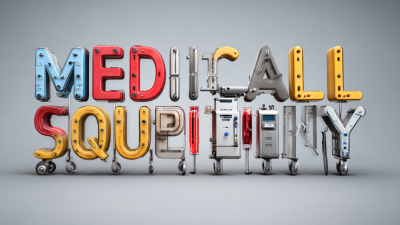Click here to browse our On The Mend Portfolio!
15 Tips to Optimize Your Surgical Supplies Procurement Process for Better Efficiency
In today's fast-paced healthcare environment, optimizing the procurement process for surgical supplies has become increasingly critical. A recent report from the Healthcare Supply Chain Association indicated that inefficient procurement practices can lead to a staggering 25% increase in hospital operating costs, underscoring the need for strategic improvements. As surgical supplies represent a significant portion of a hospital's budget—often accounting for 30% of total supply expenses—enhancing the procurement process not only boosts operational efficiency but also ensures that healthcare providers can deliver timely and effective patient care. With the right strategies in place, healthcare institutions can minimize waste, streamline their inventory management, and ultimately enhance their bottom line. This article presents 15 actionable tips on how to refine your surgical supplies procurement process for better efficiency and effectiveness.

Streamlining Communication Channels with Suppliers for Faster Responses
 Effective communication channels are essential for optimizing the procurement process of surgical supplies. Establishing clear lines of communication with suppliers allows for quicker responses to orders, inquiries, and potential issues. Utilizing modern communication tools, such as instant messaging platforms and dedicated procurement software, can enhance collaboration and ensure that all stakeholders are on the same page. Regular check-ins and updates also foster transparency, reducing the chances of misunderstandings and delays.
Effective communication channels are essential for optimizing the procurement process of surgical supplies. Establishing clear lines of communication with suppliers allows for quicker responses to orders, inquiries, and potential issues. Utilizing modern communication tools, such as instant messaging platforms and dedicated procurement software, can enhance collaboration and ensure that all stakeholders are on the same page. Regular check-ins and updates also foster transparency, reducing the chances of misunderstandings and delays.
Moreover, nurturing supplier relationships through consistent communication can lead to better negotiation outcomes and improved service levels. When suppliers feel engaged and informed, they are more likely to prioritize your orders and provide timely solutions to any logistical challenges that may arise. Creating a feedback loop where both parties can share insights and concerns can further refine the procurement process, leading to enhanced efficiency and ultimately better patient care. By focusing on streamlining communication channels, healthcare organizations can significantly enhance their procurement operations and responsiveness.
Implementing Inventory Management Software to Track Surgical Supplies
Implementing inventory management software is crucial for streamlining the procurement process of surgical supplies. This technology enables healthcare facilities to keep an accurate record of stock levels, prevent shortages, and avoid overstocking, which can tie up valuable resources. By automating the tracking of surgical supplies, the software delivers real-time updates, allowing staff to quickly identify what is needed and when. This proactive approach not only saves time but also reduces the likelihood of last-minute scrambles for essential items during surgeries.
Moreover, integrating inventory management software fosters better communication between procurement and clinical teams. With centralized data accessible to all stakeholders, decision-making becomes more informed and efficient. This collaboration helps in forecasting needs based on surgical schedules, patient load, and historical usage data. Ultimately, the use of advanced inventory management solutions enhances overall operational efficiency, leading to improved patient care and reduced costs associated with supply chain disruptions.
Utilizing Data Analytics to Forecast Supply Needs and Trends
The surgical supplies procurement process can greatly benefit from harnessing data analytics for forecasting supply needs and trends. By analyzing historical data and market trends, healthcare organizations can gain valuable insights into anticipated demand fluctuations. This predictive capability allows for more accurate inventory management and reduces the challenges associated with overstocking or stockouts, ultimately leading to improved efficiency in the procurement cycle.
The global supply chain analytics market, valued at $9.46 billion in 2024, highlights the growing significance of data-driven decision-making within supply chains. With a projected growth rate that could reach $11.08 billion by 2025 and soar to $32.71 billion by 2032, businesses are increasingly investing in advanced analytics tools. These advancements will empower organizations to enhance real-time visibility into their supply chains, optimize routes, and forecast demand with greater precision, which is essential in managing surgical supplies effectively. As the logistics and supply chain AI market is also expected to expand significantly, integrating these technologies will be key to streamlining operations and enhancing overall procurement efficiency.

Centralizing Procurement Processes to Reduce Redundancies
Centralizing procurement processes is a crucial step towards enhancing efficiency in surgical supplies management. By consolidating purchasing activities, healthcare organizations can significantly reduce redundancies that often lead to increased costs and wasted time. A centralized system allows for a streamlined approach where all departments can communicate and collaborate, ensuring that everyone is on the same page when it comes to inventory needs and supplier relationships. This not only facilitates better negotiation with vendors but also ensures consistent quality and pricing across the board.
Furthermore, centralization promotes data transparency and accessibility. With a unified system in place, procurement teams can easily track supply usage patterns, forecast future needs, and manage stock levels more effectively. This leads to improved budgeting practices, as organizations can make informed decisions based on real-time data rather than relying on estimates or past experiences. Ultimately, a centralized procurement process not only fosters operational efficiency but also enhances the overall quality of care by ensuring that surgical teams have the necessary supplies at their fingertips when they need them most.
Establishing Clear Metrics for Evaluating Supplier Performance
Establishing clear metrics for evaluating supplier performance is crucial in optimizing your surgical supplies procurement process. Metrics such as delivery timeliness, product quality, and supplier responsiveness help in creating a comprehensive performance evaluation framework. According to a systematic review of supply chain risk management, organizations that leverage data quality and supplier evaluation frameworks have been shown to improve their operational efficiency by up to 20%. Implementing tools such as supplier scorecards can provide tangible data, assisting procurement teams in making informed decisions.
To enhance efficiency, focus on building closer relationships with suppliers. This involves regular communication and setting clear expectations that align both parties' goals. For instance, studies on strategic partnerships indicate that collaborative procurement can lead to significant cost savings and higher quality supplies, demonstrating that engaging suppliers in the decision-making process can yield mutual benefits. It's also essential to review supplier performance regularly, analyzing metrics that reflect both current capabilities and future potential—a practice that can improve supply chain resilience and performance dramatically.
15 Tips to Optimize Your Surgical Supplies Procurement Process for Better Efficiency - Establishing Clear Metrics for Evaluating Supplier Performance
| Metric | Description | Measurement Frequency | Current Status | Target Status |
|---|---|---|---|---|
| On-Time Delivery Rate | Percentage of orders delivered on or before the agreed delivery date. | Monthly | 85% | 95% |
| Quality Assurance Compliance | Percentage of products that meet quality standards upon first inspection. | Quarterly | 90% | 98% |
| Order Accuracy | Percentage of orders that are fulfilled accurately without errors. | Bi-Monthly | 92% | 99% |
| Supplier Lead Time | Average time taken from order placement to delivery. | Monthly | 12 days | 7 days |
| Cost Savings | Amount saved through negotiated contracts and bulk purchasing. | Annually | $50,000 | $100,000 |
Related Posts
-

Premium Medical Accessories Crafted by China's Leading Manufacturers for Global Trust
-

5 Best Medical Accessories Driving 2023 Global Healthcare Procurement Trends
-

Transforming Healthcare with Medical Supplies 5 Key Benefits Driving Global Procurement Strategies
-

How to Choose the Right Health Care Supplies for Your Needs
-

Exploring the Features and Applications of Top Medical Supply Equipment: A Complete Buyer’s Guide
-

How to Choose the Right Health Equipment for Your Wellness Journey
View Products
- Bathroom Safety & Shower Systems
- Canes, Knee Walkers, Rollators & Wheelchairs
- Compression Socks, Stockings & Custom Garments
- CPAP Machines, Devices, Accessories & Supplies
- Incontinence Supplies
- Lift, Reclining, and Sleeper Chairs
- Power Scooters, Power Chairs & Accessories
- Ramps & Handicap Access
- Stair, Platform & Portable Lifts
- Blog
Our Locations
Visit Us in CT, NY & CA
Looking for a 'medical store near me'? Call On The Mend for the equipment and service you need!
